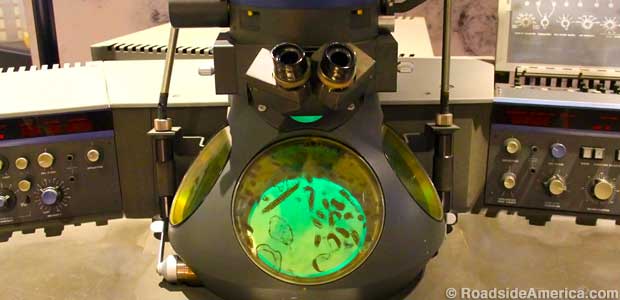
CDC electron microscope display reveals another horrible infectious disease.
Centers for Disease Control Museum
Atlanta, Georgia
Nature is trying to kill you. The Centers for Disease Control is trying to keep you alive.
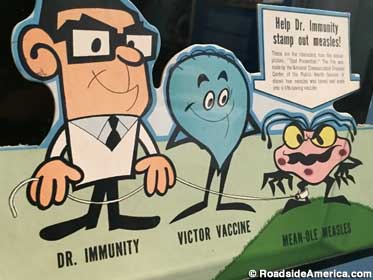
Dr. Immunity has leashed Mean-Ole Measles for the good of humankind.
That's the message we took away from the Centers for Disease Control Museum, which is at CDC Headquarters in Atlanta.
Why is the CDC here? It's because the CDC's original job (1946) was to fight malaria, and Georgia at that time had a lot of malaria. The President of Coca-Cola (headquartered in Atlanta) gave CDC the land it now uses for its headquarters (and museum) because he wanted malaria wiped out -- it inconvenienced him when he went hunting.
Since then, the CDC's roster of foes has grown considerably, as the museum's wide-ranging exhibits make clear. There's a hopeful spin to the place; you don't hear much about polio any more, thanks in part to the CDC, and it did in fact purge malaria from Georgia. But the bad things never seem to stop.
Walking through the CDC Museum is like a trip down Screaming Headline Memory Lane, recalling all of the outbreaks and public health horrors that you'd blissfully forgotten. Remember SARS? West Nile Virus? The Bird Flu? They're all here, and more. An Ebola Virus cryo-shipper on display still has its FedEx labels attached. The Legionnaires' Disease exhibit features a jug of the infected water that killed many people; a sign reassures visitors that its deadly bacteria is no longer alive. A "Lessons Learned" look at the Swine Flu panic of 1976 admits that the vaccine was far more dangerous than the flu, which never materialized. The failure, says the exhibit, "helped us prepare for pandemics in this century."
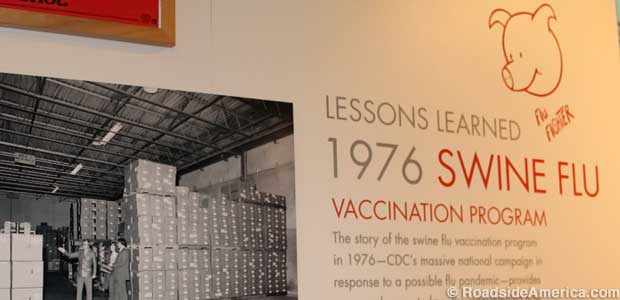
Swine Flu vaccination program: 40 years ago it was a public health debacle, today it's a learning experience.
Paranoid yet? You can try on a Biosafety Level 4 hazmat suit for fun, and the "Don't Worry" display tries to cool jitters by stressing that the shipments sent daily to the CDC -- literally only feet away from where you're standing -- have been "dropped out of planes, bounced on runways, and placed under hydraulic presses" to test their security, and that the packages "passed the tests with flying colors."
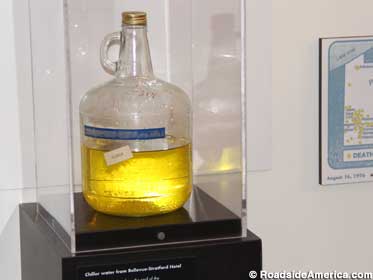
Glowing jug of Legionnaire's Disease water: colorful but deadly.
The CDC surprises with its forays into areas you might not normally associate with disease. "I've been here 35 years, and nearly every day I find something we do that I didn't know about," said Judy Gantt, the museum's director. There's a display about the "extraterrestrial pathogens" quarantine trailer that the CDC helped design for the early moon missions. There's the CDC's first smoking machine -- a big syringe attached to the filter end of a cigarette. And there's a display about the CDC's attempt to predict likely serial killer victims using epidemic analysis (It didn't work as well as hoped). We were dazzled by the "Measuring What We Eat" exhibit, a selection of ghostlike visual aids of food portions and containers. The CDC takes these around the U.S. every year, surveying 5,000 random Americans, "to recall all food consumed over a 24-hour period."

The goal of "preparedness," according to various displays, has been at the forefront of the CDC since 9/11 and the anthrax attacks of 2001. This led to an unlikely pop culture partnership in 2011 when the CDC launched its Zombie Apocalypse blog, piggybacking on the popularity of The Walking Dead, reasoning that, "if you're prepared for a zombie apocalypse, you're prepared for pretty much anything." Although the museum has preparedness exhibits ranging from cases of unopened Cipro to the electronic alert board from the CDC Emergency Operations Center, there's no mention of zombies in the museum -- not surprising on the one hand, but on the other a disappointment for fans of the show who otherwise might not have visited.
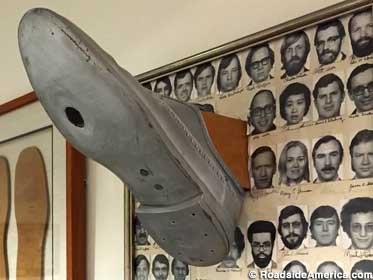
Epidemic Intelligence Service, class of 1974, wore out this shoe looking for disease.
"We did have a group of middle-aged visitors who asked one time, 'Where are the zombies?'" said Judy. "They were not joking. They really believed we had zombies here."
Zombies aside, the museum bookends its exhibits with two particularly nasty nonhuman villains. Smallpox kicks it off, featuring what the museum considers to be its most iconic artifact: Shapona, "the god of smallpox." Sculpted in Nigeria in 1969, it is, according to its display, "decorated with a monkey skull, cowrie shells, and the tail of a bush porcupine." The elimination of smallpox (and Shapona) is one of the CDC's great success stories. Once accomplished, the agency set out to tackle Guinea Worm, a horrifying parasite that grows up to three feet long inside you, then eats its way out through your skin. The museum displays gruesome illustrations of the worm in action, and an actual specimen in a jar. "Patients must wait for weeks as the worm is excruciatingly pulled out by being slowly wrapped around a stick." This is the last exhibit you see before reaching the hand sanitizer at the museum exit.
The CDC's job is serious, so it's understandable that its museum stresses education and steers clear of typical tourist hucksterism. But Judy shared our disappointment -- and apparently the frustration of others -- at the lack of a CDC museum gift shop; she said it had been turned into additional exhibit space. "There are plans to reopen it, perhaps," said Judy, cautiously. "Believe me, I hear about it a lot."





